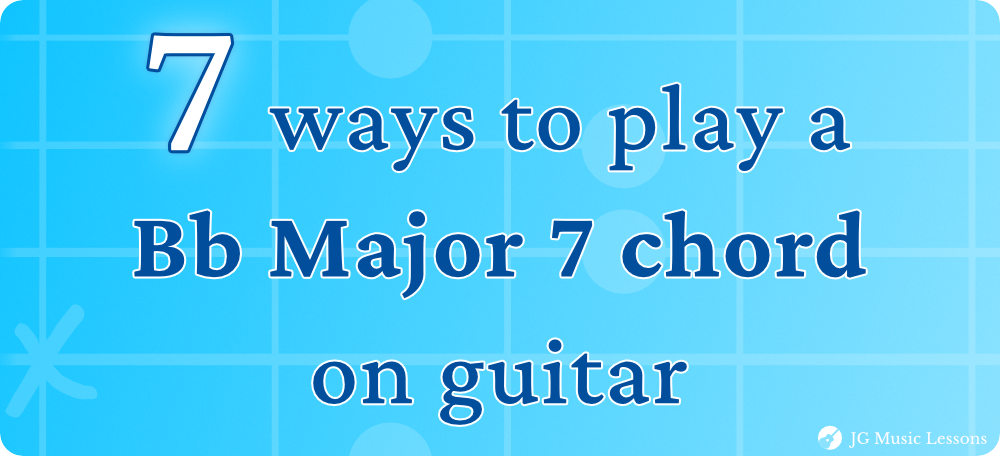Major 7 chords have a smooth, jazzy, and sophisticated sound that can instantly elevate your playing. They’re great for adding richness and warmth to progressions whether you’re playing jazz, soul, R&B, or even pop.
In this lesson, we’ll focus on the Bb Major 7 chord and go over 7 ways to play it on the guitar. From beginner-friendly shapes to fuller voicings across the neck, you’ll find a version that fits your style and level.
Grab your guitar and let’s dive in!
✨ This PDF is included free with Pro Membership
Bb Major 7 chord theory intro
Every Major 7 chord is built upon the following four chord tones: 1, 3, 5, and 7. These chord tones can also be thought of as the scale degrees related to a Major scale.
For example, the Bb Major 7 chord has the chord tones Bb, D, F, and A. This is essentially a Bb Major chord with an added 7th chord tone.
Here is the formula for Major 7 chords below:

In contrast, minor 7 chords contain the chord tones 1, b3, 5, and b7. For example, a Bb minor 7 chord would contain the chord tones Bb, Db, Fb, and Ab. However, we will only be covering the different Major 7 chord variations in this lesson.
Now that you know what notes belong to the chord structure, let’s look at how to read the chord charts.
How to read the chord charts
For the charts below:
- The top horizontal line of the chord chart represents the high E string and the bottom horizontal line represents the low E string.
- The vertical lines separate each fret.
- The numbers in the blue dots tell you which fingers to use on the fretting hand.
- The letters on the right of the charts tell you what notes you are playing on each string.
- Circles on the left represent open strings.
- Red X means to avoid that string.
You can check this link for more on how to read guitar notation symbols.
Bb Major 7 on the 5th string
This first shape is a common movable chord that starts on the 5th string and is based on the open A Major 7 chord. If you’re having trouble getting it to sound clear, start by focusing on the notes from the 5th to the 2nd string. Once your fingers gain more strength and control, try adding the 1st string to turn it into a barre chord.
* Notes in parenthesis are optional.
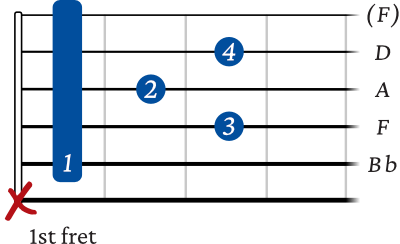
If needed, check out these 5 tips to get better at playing barre chords.
Bb Major 7 6th string (drop 3)
Here is another common movable shape used for Major 7 chords. This is called a drop 3 chord because the 3rd note from the top (Bb) gets lowered by an octave.
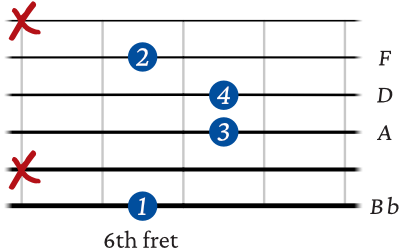
Bb Major 7 barre chord 6th string
This barred chord shapes shares all the same notes with the previous drop 3 chord shape. However, we have to rearrange our fingers and add a barre to play every string. This shape comes from the open E Major 7 chord.
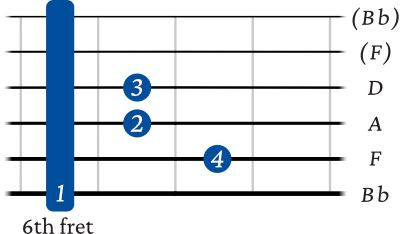
As a side note, I would be cautious with the Bb note on the 1st string because it can sound dissonant with the A note on the 4th string (minor 9 interval below). Although the note belongs to the chord, use your ears and judgment to see if you want to add this string to the chord voicing.
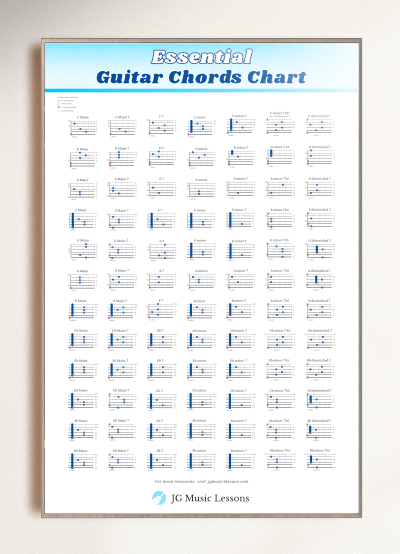
Bb Major 7 mini barre chord
This shape uses a mini barre chord starting on the 4th string, 3rd fret. This is technically a drop 2 chord because the 2nd note from the top (F) gets lowered by an octave.
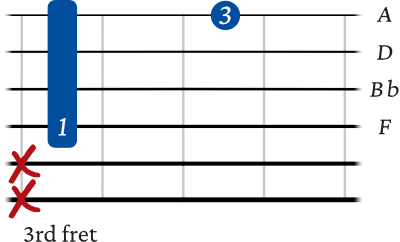
Bb Major 7 on the 4th string
Here is another common drop 2 chord shape starting on the 4th string. In this case, the 2nd note from the top (Bb) gets lowered by an octave.

Another way you can play this shape is by barring the notes on the 1st, 2nd, and 3rd string with your 3rd finger. Go with whatever is more comfortable for you.
Bb Major 7 diagonal shape
Here’s one more Bb Major 7 chord starting on the 4th string, 8th fret, which comes from the open F Major 7 shape. This chord is easier to remember because of the diagonal shape across the top four strings.
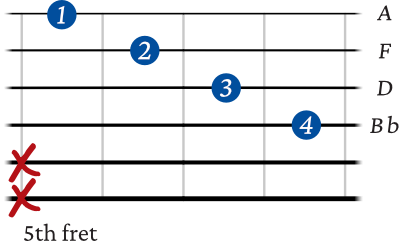
Bb Major 7 5th string variation
This shape is based on the open C Major 7 chord. If it feels like too much of a stretch at first, try playing it without your pinky (4th finger). Focus on getting the barre and your 3rd finger in place first. Once that feels comfortable, add the note on the 4th string. With consistent practice, it will get easier over time.
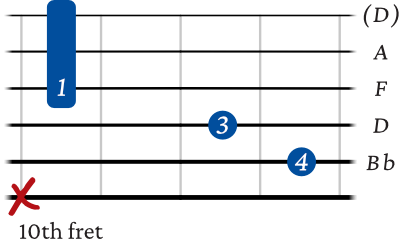
✨ This PDF is included free with Pro Membership
Wrapping up
All of these shapes were mostly in root position, which means the root note is in the bass. You can discover even more variations by exploring chord inversions, where a different note from the chord, such as the third or seventh, is played in the bass.
Learning multiple ways to play the same chord gives you more flexibility to move around the fretboard. It also allows you to choose chord shapes that highlight certain notes, especially when you want to support a melody.
I hope this helped you understand how to play the Bb Major 7 chord, or gave you some fresh ideas for using it in your playing. You can also try moving the fully fretted shapes up or down the neck to play other Major 7 chords on the same string set.
If you are interested in improvisation, be sure to check out the lesson on Major 7 arpeggios to hear how this chord can be used in melodic lines.
📘 Get the free guitar practice guide here!
All the best,
JG Music Lessons
Start Playing Better, Faster
with Pro Membership! ✨
Get the guidance, tools, and support that keep your progress on track:
🏁 Always know what to practice next. Access the full Guitar Learning Roadmap with lessons in sequence.
🎼 Play songs with confidence. Step-by-step lessons of popular, classical pieces and other styles.
📙 Save time and frustration. Clear PDFs and ebooks that save time so you can focus on playing.
🎟️ Get rewarded for consistency. 2 free downloads every month (a $240+ yearly value).
🎁 Keep costs low while you grow. 50% off all charts, tracks, and posters — up to 75% off bundles.
🚫 Stay focused. Ad-free environment keeps you in the zone.
💬 Get help when you need it. Direct member support to keep you on track.

